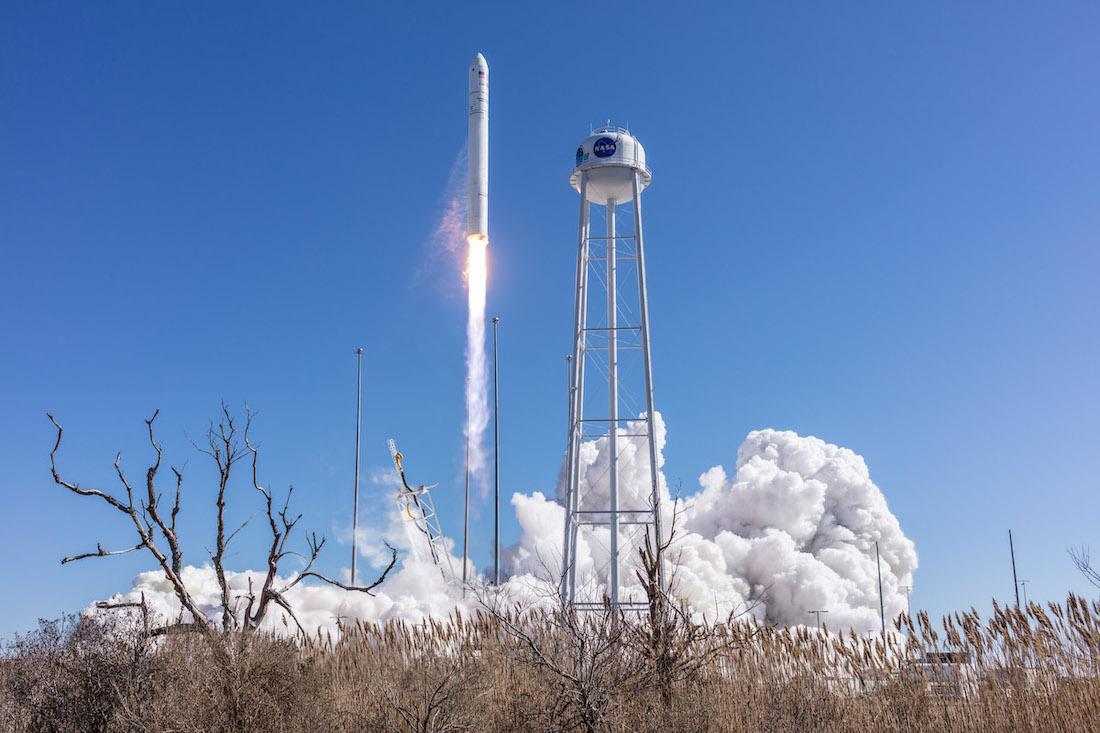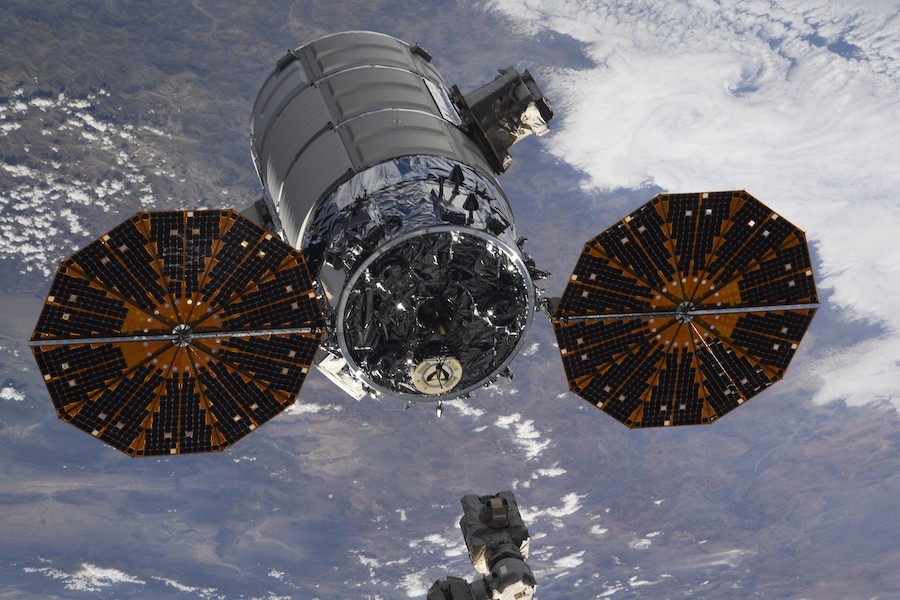
Northrop Grumman launched a cargo flight from Virginia’s Eastern Shore Saturday using an Antares booster with a first stage designed and built in Ukraine, a successful start for a mission to deliver food, experiments, and supplies to the seven-person crew on the International Space Station.
Twin Russian-made RD-181 main engines flashed to life and powered the 139-foot-tall (42.5-meter) Antares rocket off of pad 0A at the Mid-Atlantic Regional Spaceport on Wallops Island, Virginia.
The kerosene-fueled booster stage throttled up and climbed away from the Virginia coastline at 12:40:03 p.m. EST (1740:03 GMT) Saturday, steering on a trajectory toward the southeast to line up with the space station’s flight track.
The RD-181 first stage engines produced more than 860,000 pounds of thrust for the first three minutes of the flight, before throttling down and switching off to give way to the rocket’s solid-fueled upper stage. The upper stage ignited after nearly minute-long coast to accelerate to orbital velocity.
The Antares upper stage deployed Northrop Grumman’s Cygnus cargo freighter nearly nine minutes after blastoff, and NASA confirmed a few hours later that the spacecraft unfurled its two fan-shaped solar arrays, a key milestone to begin generating electrical power for the 40-hour pursuit of the space station.
A series of thruster burns will guide the Cygnus spacecraft toward the space station, culminating in the supply ship’s capture by the space station robotic arm at 4:35 a.m. EST (0935 GMT) Monday. NASA astronauts Raja Chari and Kayla Barron will operate the Canadian-built robot arm to grapple the Cygnus supply ship, and ground teams will command the arm to berth the spacecraft on the bottom port of the station’s Unity module, where it will stay more than three months.
Liftoff of Northrop Grumman’s Antares rocket from Virginia, hauling 8,300 pounds of crew provisions, life support hardware, biomedical and plant growth experiments, and technology demonstrations to the International Space Station.https://t.co/sCTZQhiT5u pic.twitter.com/bHKUVktFkv
— Spaceflight Now (@SpaceflightNow) February 19, 2022
Dina Contella, NASA’s operations integration manager for the International Space Station program, said cargo missions like the Cygnus resupply flight are “critical for supplying the science investigations that make the International Space Station the incredible research facility that it is.
“Of course, the cargo flights also provide supplies for the crew and critical maintenance teams and hardware to make the changes necessary for the ISS to support new science,” Contella said in an interview broadcast on NASA TV.
“This particular flight of research that’s coming up, for example, includes investigations looking at the effects of a drug on cancer cells,” she said. “We’ve got investigations on skin aging, plant growth. We’re looking at new hydrogen sensors. This science provides direct benefits to those on Earth as well for future human spaceflight crews and future spaceflights.”
The mission, known as NG-17, is also carrying a modification kit to prepare for the arrival of a new pair of upgraded solar arrays at the space station on a future SpaceX cargo flight. There’s also a trash disposal system that will allow garbage to be jettisoned out of the Nanoracks airlock.
“Regular cargo missions are the life blood, really, of ISS’s supply chain to continue research, especially as we’re continuing to extend station operations through 2030,” Contella said.
This Cygnus mission will also debut a new capability to reboost the altitude of the space station, a service that has been exclusively provided by Russia since the retirement of the space shuttle in 2011.
“This Cygnus vehicle has been modified to provide a capability to reboot ISS, so to use some of its propellants in the vehicle itself,” Contella said. “We’ve done a test prior to this with Cygnus, but this will be our first real use of this capability to actually reboost the station. And it gives us another way to do so, in addition to the Russian thrusters or the Russian Progress cargo spacecraft capabilities.”

The Cygnus supply freighter will be the second cargo ship to arrive at the space station in less than a week, following the successful docking of Russia’s Progress MS-19 spacecraft at the complex Thursday.
The Cygnus mission will deliver more than 8,300 pounds (about 3,800 kilograms) of cargo to the space station. Here’s a breakdown of the NG-17 cargo manifest:
• 2,980 pounds (1,352 kilograms) of crew supplies
• 2,883 pounds (1,308 kilograms) of vehicle hardware
• 1,975 pounds (896 kilograms) of science investigations
• 200 pounds (100 kilograms) of unpressurized cargo
• 132 pounds (60 kilograms) of spacewalk equipment
• 77 pounds (35 kilograms) of computer resources
NASA has multibillion-dollar contracts with Northrop Grumman, SpaceX, and Sierra Nevada Corp. to ferry cargo to and from the space station. Northrop Grumman’s two resupply contracts cover 19 operational cargo missions through 2023, with the next two Antares/Cygnus launches scheduled in August and in April 2023.
The Cygnus spacecraft flying on Northrop Grumman’s NG-17 mission is named the “S.S Piers Sellers” in honor of a space shuttle astronaut and NASA climate scientist who died from cancer in 2016.
Along with spare parts and equipment to keep the space station running, the Cygnus cargo freighter is packed with more than a ton of scientific research gear.
The experiments heading to the space station on the NG-17 mission include an investigation studying engineered human skin cells to evaluate how they change in microgravity. Deterioration of skin tissue is a normal part of aging. Similar changes occur in the human body in space, but they happen much more quickly.
Researchers will study the skin cells in space in hopes of using them as a model to assess products to protect against skin damage from aging back on Earth.
The Cygnus mission will also carry to the space station a combustion experiment to assess the flammability of different types of materials that could be used on future space missions, such as human expeditions to the moon and Mars.
There is also a technology demonstration experiment to evaluate new sensors that can better detect hydrogen generated as a byproduct of the space station’s oxygen generation system.
Another experiment will look into using hydroponic, or water-based, and aeroponic, or air-based techniques to grow plants on the space station. Astronauts so far have used conventional soil to grow vegetables on the station, but hydroponic and aeroponic systems could offer advantages in size and mass for future missions into deep space.
The Cygnus spacecraft will also launch with a Japanese tech demo of a new lithium-ion battery that could be used on future space missions, plus CubeSats for deployment from the space station module and outside the Cygnus cargo ship itself in the next few months.
Email the author.
Follow Stephen Clark on Twitter: @StephenClark1.
